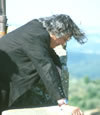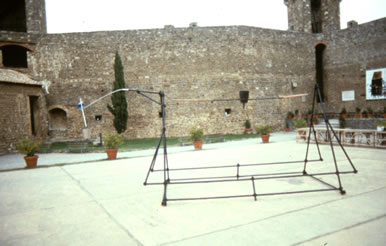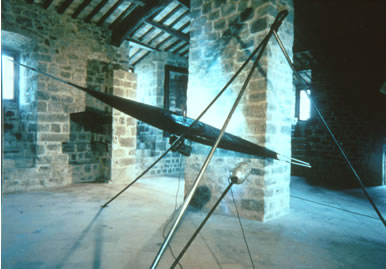 |
Fire, tension, energy, weight, balance, movement, canoe,
javelin, star, engine, space, time, odors, structure, sounds, danger...
these are just a few of the characterising elements of Gilberto Zorio's
art. It was him, together with his friends grouped together in the Humble
Art, who introduced new materials, new energies and new qualities in the
world of art starting from the late Sixties.  He
thus asserted an art which was not illusory nor a mere representation
of objects, but rather it was a presentation of phenomena and of reality.
In fact, the list of words with which this essay opens would be in itself
sufficient to talk about this phenomenal art that - like life itself -
is made not as much of what we see and ponder as a fact, as of what we
experience. In Zorio's art, in fact, nothing "is" but everything
"happens": there are neon lights that light up, laser beams
tracing drawings, iron bars moving, alembics with boiling liquids inside,
structures that rotate, objects that whistle, wineskins that swell - and
amidst all this we stay watching like the onlooker in the middle of a
futuristic scene. All is realised by means of elements and forms that
belong to the past, the present and the future alike: canoes are representative
of a moving condition, javelins of the strength of the muscles, the stars
are a portrayal of the universe, leather is seen as a second skin for
the humans as fireclay is a second skin for the earth, the melting-pot
is like an alchemic pipe, copper conveys energy, the lamps light up reality. He
thus asserted an art which was not illusory nor a mere representation
of objects, but rather it was a presentation of phenomena and of reality.
In fact, the list of words with which this essay opens would be in itself
sufficient to talk about this phenomenal art that - like life itself -
is made not as much of what we see and ponder as a fact, as of what we
experience. In Zorio's art, in fact, nothing "is" but everything
"happens": there are neon lights that light up, laser beams
tracing drawings, iron bars moving, alembics with boiling liquids inside,
structures that rotate, objects that whistle, wineskins that swell - and
amidst all this we stay watching like the onlooker in the middle of a
futuristic scene. All is realised by means of elements and forms that
belong to the past, the present and the future alike: canoes are representative
of a moving condition, javelins of the strength of the muscles, the stars
are a portrayal of the universe, leather is seen as a second skin for
the humans as fireclay is a second skin for the earth, the melting-pot
is like an alchemic pipe, copper conveys energy, the lamps light up reality.
The artist chooses this kind of objects because they are not helpless,
but rather they are witnesses of the history of humanity, a link between
the origin of the world and our experiencing it. Zorio's is the art of
the metamorphosis for life itself is a constant metamorphosis, a changing
and developing of our being by means of the experience the artist makes
handling with the matter. Zorio's work cannot be considered as a mere
assembling of objects, it is rather a constructing and handling with matter
and with things which is made possible by the great manual skill the artist
possesses.
The great task Zorio engaged in since the late Sixties was that of making
us aware of the importance of manuality, of making and of the human senses
as a whole. By so doing he speaks about the gap between nature and culture,
of the fall of man upon the earth and of his progressive reducing the
range of some senses in favor of others, or rather, of just one of them:
sight. As we all know, the predominance of sight has led man towards the
modern age widening the difference between man and all other animals,
that have kept all their senses sharp: olfaction, touch, hearing and taste.
All this obviously ends up in questioning the meaning of art for it comes
as a natural conclusion that art cannot be sufficiently decribed as a
"visual art" any more. In fact, when we are approaching one
of Zorio's works or an exhibition of his works we can smell it and hear
it from far away, just like when we take a walk in the woods and start
smelling the trees and hearing the calls of the animals. He says in fact:
"The noise is part of the work for it is a plastic fact" And
again. "That's why I made works with voltaic arcs which sound like
crystal waterfalls" or like "Scrittura bruciata, where the burnt
gas reminds of the breathing of an animal". It is this primordial
quality that is recalled, these senses that are aroused and made sensitive
again by deafening whistlings or sour odors wafting up when we are in
front of his works or near them. "The odor means a lot ot me for
I realised several works enjoying the sour smell of the purifying sulphur,
or that of alcohol which imbues your whole being, that of ozone taht inebriates,
or the sharpness of copper and bronze, of the strength of iron and of
the animal quality of leather, all of them wafting up in the air".
So it is not only us moving towards the work of art with our eyes and
all our senses, but it is the work itself that comes towards us with its
odors, sounds and humors spreading all over the place. It is an expansion
in space that goes all directions of the place, therefore setting aside
any humanistic front-view perspective in favor of a different experiencing
of the work in all the apects of its spreading in the air. Air is another
important element of his art for many of his works represent an attempt
to master gravity and to float in the air, thus joining the cosmic space
again; or maybe they are just an attempt to experience the same feeling
he experienced when he was a little kid in Termoli and a strong wind blew
him away, up in the air. So - as usual - art turns into biographical data
and history, linking personal and collective aspects, because art is in
itself a consequence and a follow-up of history, reproducing and witnessing
it. In fact, we owe our memories of ancient times to the archaeological
finds which we call art, or that at least suggest some idea of art to
us, whatever their original meaning might have been. This not only gives
them their importance as a form of visual art, it makes them important
for the deep signifcance of our existence, too, and this attests the need
the whole humanity has that there be art, as well as the desire human
beings feel to go back to art continually.  Zorio's
works point out a way of experiencing life through art and of becoming
aware of history due to the fact that they need a temporal dimension to
exist and to be enjoyed, because they are structures which are not completed,
they are constantly moving and changing their position, their form and
their spirit; for these reasons, they cannot be experienced in a single
glance, just like life itself. The artist adds: "In these last few
years I made discoveries that belong to an atavistic memory: the canoe,
the javelin, are cosmic structures, widespread in the whole world and
global". Up to this moment we referred to the past and described
this art as witnessing history and pre-historic times, and yet we must
say that it is precisely their space-related structure that makes them
look as if they were machines coming from some other planet, from different,
maybe future worlds, machines which are wonderful for life and - as the
artist himself says - carrier of "an energy that can exorcise death".
So it is not only the artist going back to art, because it is rather him
who creates art and who enables us to experience art through his works
and to move on from life to art. This we do every time we find ourselves
facing a real artistic masterpiece, such as in the Rocca di Montalcino,
where Zorio has constructed one of his flying sculptures, one of his machines
for balance and alchemic transformation. It is a metamorphosis which is
not shown as much in the slow changing of the verdigris as in the casual
expanding of water, that same water which is both a basic element and
an original and fecundating liquid which falls from above and, such as
is the case here, generates and bestows the energy that creates art and
life. Zorio's
works point out a way of experiencing life through art and of becoming
aware of history due to the fact that they need a temporal dimension to
exist and to be enjoyed, because they are structures which are not completed,
they are constantly moving and changing their position, their form and
their spirit; for these reasons, they cannot be experienced in a single
glance, just like life itself. The artist adds: "In these last few
years I made discoveries that belong to an atavistic memory: the canoe,
the javelin, are cosmic structures, widespread in the whole world and
global". Up to this moment we referred to the past and described
this art as witnessing history and pre-historic times, and yet we must
say that it is precisely their space-related structure that makes them
look as if they were machines coming from some other planet, from different,
maybe future worlds, machines which are wonderful for life and - as the
artist himself says - carrier of "an energy that can exorcise death".
So it is not only the artist going back to art, because it is rather him
who creates art and who enables us to experience art through his works
and to move on from life to art. This we do every time we find ourselves
facing a real artistic masterpiece, such as in the Rocca di Montalcino,
where Zorio has constructed one of his flying sculptures, one of his machines
for balance and alchemic transformation. It is a metamorphosis which is
not shown as much in the slow changing of the verdigris as in the casual
expanding of water, that same water which is both a basic element and
an original and fecundating liquid which falls from above and, such as
is the case here, generates and bestows the energy that creates art and
life.
And yet if water naturally gives rise to life and to art, fire is the
other element whose energy man has used as a creative force; in fact,
it was thanks to the control over fire that it was possible to develop
a spiritual and lay civilization able to write the Tables of the Law,
to cast the Golden Calf, to forge iron and to transform the food by cooking
it. It is this creative power of the fire that Zorio makes visible for
one night in the bailey of the Rocca, presenting a glassblower shaping
alembics, that is, alchemic and chemical containers for the transformations
of the matter as well as objects which the artist has been inserting for
a long time in his works, so that the creative process of art might enable
us to understand the process of the creation of life, too.
Giacinto di Pietrantonio
 .
|
|